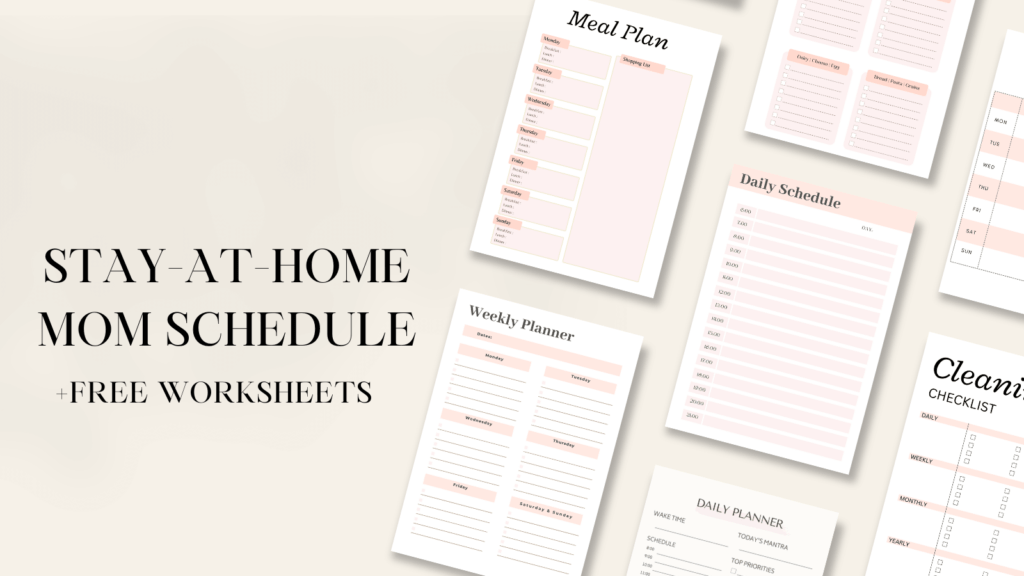This post contains a stay at home mom schedule along with helpful tips to help you stay organized and get things done.
Importance of Having A Schedule
As a stay-at-home mom, having a schedule is essential for managing your household and keeping everyone’s needs in balance.
Some of the reasons why having a schedule is important for a stay-at-home mom are:
1. Time Management: When you create a schedule for yourself, you can manage your time better and complete your tasks on time. A schedule helps you prioritize your day, so you can focus on the most important things first.
2. Preventing feeling overwhelmed: Raising a family, running a household, and taking care of your own needs can be overwhelming. With a schedule in place, you can break down your tasks into manageable chunks, which makes everything feel less daunting.
3. Providing structure for your family: Children thrive on routine and predictability. Having a schedule in place provides them with structure and helps them develop good habits.
4. Ensuring everyone’s needs are met: A schedule helps you keep track of everyone’s needs, from meals to homework to extracurricular activities. This ensures that everyone is taken care of.
5. Finding time for yourself: As a stay-at-home mom, it can be challenging to find time for yourself. By scheduling in some “me time,” you can ensure that you have time to recharge and pursue your own interests.
Related: Top 12 Benefits of Stay At Home Mom
Planning Your Schedule
As a stay-at-home mom, planning your day-to-day schedules can be both challenging and rewarding.
To help make the most of your time at home, below are some initial planning tips for creating a schedule:
1. Determine your priorities – Start by identifying your top priorities for the day, such as caring for your children, preparing meals, completing household chores, exercising, or pursuing personal interests.
2. Create a daily routine – Develop a daily routine that incorporates your priorities. For example, you might dedicate certain times of the day for caring for your children, cooking meals, cleaning, exercising, or working on personal projects.
3. Be flexible – Recognize that unexpected tasks or events may arise throughout the day, which could require you to adjust your plans as needed. By remaining flexible, you can better accommodate these situations without feeling overwhelmed.
4. Schedule breaks – Make sure to schedule time for yourself, whether it’s a few minutes to read, meditate, or simply relax. Taking regular breaks can help prevent burnout and increase your overall productivity.
5. Involve your family – Consider involving your family members in your daily routine. Children can help with chores and meal preparation, while partners or spouses may be able to provide additional support throughout the day.
Remember that every family’s situation is unique, so be sure to tailor your schedule to meet your specific needs and preferences.
With a well-planned schedule, you can enjoy a productive and fulfilling day at home as a stay-at-home mom.
Related: Best 8 Books For Stay At Home Mom
Stay At Home Mom Schedule
As a stay-at-home mom, you may have a lot of responsibilities to handle on a daily basis.
Here’s an ideal routine that you could follow to make the most of your time:
6:00 am – Wake up and get ready for the day
6:30 am – Prepare breakfast for yourself and family
7:00 am – Wake up children, help them with their morning routines
8:00 am – Drop children off at school (if applicable)
9:00 am – Start housework such as cleaning, laundry, and tidying up
10:00 am – Take a break and do something you enjoy such as reading or exercising
11:00 am – Start preparing lunch
12:00 pm – Have lunch with your family
1:00 pm – Spend quality time with children by engaging in educational activities or playing games
3:00 pm – Prepare snacks for children and help with homework
4:00 pm – Engage children in physical activities such as sports or a walk around the neighborhood
5:00 pm – Start preparing dinner
6:00 pm – Have dinner with your family
7:00 pm – Help children with any remaining homework and prepare them for bed
8:00 pm – Spend some time relaxing and unwinding before bed
9:00 pm – Get ready for bed and ensure everything is ready for the next day
Remember to prioritize self-care and take breaks when needed.
Adjust the schedule based on your family’s unique needs and preferences.
Related: Baby Items A-Z (+PDF Download)
Stay-At-Home Mom Schedule Tips and Ideas
1. Morning Routine
As a stay at home mom, it can be easy to fall into a routine of waking up and immediately starting your day.
However, setting aside some time each morning for yourself can help you feel more energized and ready to tackle the day ahead.
Here is a potential morning routine for a stay at home mom:
1. Wake up before your children to have some quiet time for self-care. This could include yoga, meditation, journaling, or simply enjoying a cup of coffee or tea.
2. Get dressed and ready for the day, even if you don’t have any specific plans. This can help you feel more put-together and motivated.
3. Make breakfast for yourself and your family. Having a healthy meal in the morning can set a positive tone for the day.
4. Spend some quality time with your children, whether that’s reading books, playing games, or just chatting.
5. Plan out your day, including any errands you need to run or tasks you want to accomplish. This can help you feel more productive and organized.
Remember, every family’s routine will look different, so don’t be afraid to adjust this to fit your specific needs and preferences.
Related: How To Sleep Train For Naps?
2. Meal Planning And Preparation
As a stay-at-home mom, meal planning and preparation can be overwhelming sometimes, especially when you have kids who need your attention.
Here are some tips to help you streamline the process:
1. Plan out meals for the week: Pick one day of the week to sit down and plan out meals for the week. This will save you time and reduce stress during the week.
2. Make a grocery list: Once you have planned out your meals, make a list of all the ingredients you need to buy. Stick to your list when you go to the grocery store to avoid overspending.
3. Prep ingredients in advance: Chop vegetables, cook grains and meats, and make sauces or marinades in advance. This will save you time when you start cooking during the week.
4. Use slow cookers and instant pots: These appliances are great for busy moms because they allow you to prepare a meal in advance and have it ready when you need it.
5. Stock up on pantry staples: Keep a well-stocked pantry with staples like rice, pasta, canned beans, and spices. These items can be used as a base for many different meals.
6. Involve your kids: Encourage your kids to help you with meal planning and preparation. This will not only teach them valuable skills but also make them more likely to eat the meals you prepare.
7. Batch cook and freeze meals: Double recipes and freeze the leftovers for future meals. This can be a real time-saver during busy weeks.
Related: When Do Babies Go From 2 Naps To 1
3. Cleaning And Organizing
Here are some practical tips you can use:
1. Create a Cleaning Schedule: One of the best ways to stay organized and ensure that your house is always clean is to create a cleaning schedule. This will help you keep track of what needs to be done and when.
Start by making a list of all the tasks that need to be done each day, such as doing laundry, sweeping the floor, or washing dishes. Then assign each task to a specific day of the week.
2. Declutter Regularly: Clutter can make your home feel chaotic and unorganized. Set aside some time each week to declutter your home.
You can start with one room at a time and focus on getting rid of anything you no longer need or use.
Consider donating or selling items that are in good condition.
3. Involve Your Kids: If you have young kids, involve them in the cleaning and organizing process.
Teach them how to put away their toys and clothes, and encourage them to help with small tasks like wiping down surfaces or sweeping the floor.
This will not only help you get things done faster but also teach your children valuable life skills.
4. Use Storage Solutions: Invest in storage solutions such as baskets, shelves, and bins to keep your home organized.
Use these storage solutions to store items like blankets, books, and toys.
5. Clean As You Go: One of the simplest ways to keep your home clean and organized is to clean as you go.
For example, when you finish cooking, wipe down the counters and put away any ingredients you used. This will help you avoid having to do a big clean up at the end of the day.
By following these simple tips, you can stay organized and keep your home clean while still enjoying time with your family as a stay at home mom.
Related: Best 10 Baby-Led Weaning Books
4. Play Time With Kids
Here are some practical tips you can use:
1. Set a schedule: Having a routine for your day helps your children feel more secure and gives them a sense of what to expect. Plan playtime into your daily schedule and try to stick to it.
2. Pick age-appropriate activities: Choose activities that are appropriate for your child’s age and developmental level, such as building blocks for toddlers, puzzles for preschoolers, or board games for older children.
3. Get outside: Fresh air and sunshine can do wonders for both you and your children. Take a walk, go to the park, or play in the backyard.
4. Let them lead: Allow your children to choose what they want to play, within reason. This gives them a sense of control, which can boost their confidence.
5. Use your imagination: Children love to use their imagination, so get creative with your playtime. Build a fort, have a tea party, or create a scavenger hunt.
6. Limit screen time: While technology can be a valuable tool, it’s important to limit the amount of time your children spend in front of screens. Encourage other forms of play for a well-rounded childhood experience.
7. Have fun: Above all, remember that playtime is supposed to be fun! Don’t stress too much about creating the perfect activity or game; focus on spending quality time with your children and enjoying each other’s company.
Related: Newborn Doesn’t Like Swaddle? Here’s What to Do Instead
Common Challenges Faced By Stay At Home Moms
Stay-at-home moms face unique challenges when it comes to setting a schedule:
1. Disruptions: Stay-at-home moms have to deal with interruptions and distractions from their children, pets, family members, and household chores. It can be challenging to find uninterrupted time to focus on tasks or activities that require concentration.
2. Lack of structure: Without a fixed work schedule, stay-at-home moms may struggle to establish a consistent daily routine. This can lead to feelings of disorganization, stress, and frustration.
3. Time management: Stay-at-home moms have to manage their time effectively to balance their responsibilities of taking care of their children, running a household, and pursuing personal interests. This often requires multitasking, prioritizing, and delegating tasks.
4. Guilt: Stay-at-home moms often feel guilty for taking time for themselves, rather than spending every moment with their children. This can make it difficult to set aside time for self-care, hobbies, or personal development.
5. Unrealistic expectations: Stay-at-home moms may feel pressure to maintain a perfect home, cook gourmet meals, and provide endless entertainment for their children. These high expectations can be overwhelming and often lead to burnout.
Take small steps towards establishing a routine that works for you.
This can include setting aside specific times for household chores, childcare, and personal time.
It’s important to prioritize self-care and delegate tasks whenever possible.
Remember that it’s okay to ask for help and that a flexible routine is sometimes necessary to accommodate unexpected interruptions.
Related: When Does Breastfeeding Get Easier? A Guide for New Mothers
Conclusion
If you are a stay at home mom, then you know how busy and hectic your days can get.
Having a schedule is crucial for a stay-at-home mom to manage their daily routine, avoid feeling overwhelmed, provide structure for their family, ensure everyone’s needs are met, and find time for themselves.
FREE Stay-At-Home Mom Printables PDF





